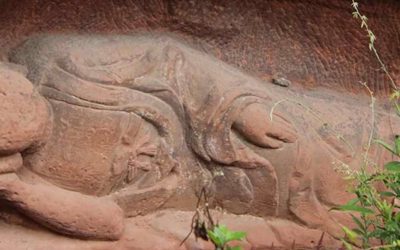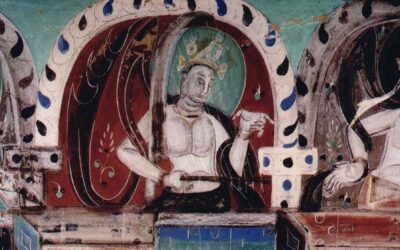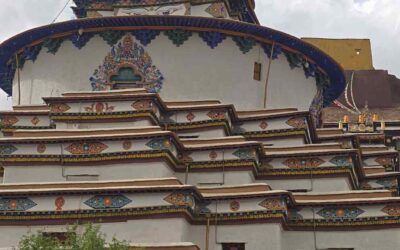The tragedy of the beauty Wang Zhaojun
Emperor Yuan (48–33 BCE) had a large harem and could not meet with all the palace women regularly. Therefore, he ordered painters to create portraits of them, and he would summon them for favors based on these portraits. Most of the palace women bribed the painters, offering as much as 100,000 coins, while even the smallest bribe was no less than 50,000 coins. However, Wang Qiang (Zhaojun) refused to bribe the painters and thus was never summoned.
Later, when the Xiongnu ruler came to pay tribute to the Han court and requested a beautiful woman to be his consort, the emperor referred to the portraits and selected Wang Zhaojun to be sent to him. On the day of her departure, she was summoned to appear before the emperor. Her beauty was unmatched among the palace women, and she excelled in conversation and carried herself with grace and elegance. The emperor regretted his decision, but her name had already been recorded, and the emperor valued his credibility with foreign nations, so he did not change the arrangement.
The emperor then thoroughly investigated the matter, and all the painters were executed in the marketplace. Their confiscated family assets amounted to enormous sums. Among the painters was Mao Yanshou from Du Ling, who was skilled at capturing the essence of a person’s appearance, whether they were beautiful or ugly, young or old, ensuring their true likeness. Chen Chang from An Ling, Liu Bai and Gong Kuan from Xin Feng were also skilled painters, specializing in depictions of animals such as oxen, horses, and birds in flight. However, their ability to depict human figures fell short of Mao Yanshou’s talent. Yang Wang from Xia Du was another talented painter, especially skilled in applying colors, as was Fan Yu. All were executed on the same day. After this incident, there were very few skilled painters left in the capital.
— Ge Hong, Miscellaneous Records of the Western Capital
Notes:
- The Han Dynasty (206 BCE–220 CE) is considered a golden age in Chinese history, marked by significant advancements in politics, economics, technology, and culture. Emperor Yuan’s reign falls within the Western Han period (206 BCE–9 CE), with the capital at Chang’an (modern Xi’an). Emperor Yuan was known for his strong support of Confucianism, appointing Confucian scholars to important government positions. He aimed to govern based on Confucian principles of virtue and social order. Its reign however was marked by factionalism among officials, leading to political infighting, and corruption within the government.
- The Xiongnu were a nomadic people who dominated the steppes north of China for centuries, particularly during the Han Dynasty. Their society was highly mobile, centered on pastoralism, with a reliance on horses and livestock. Organized into a hierarchical structure led by a Chanyu, their military prowess was formidable. Skilled horsemen and archers, they posed a constant threat to the sedentary agricultural Chinese. Raids into Han territories for resources and captives were frequent, leading to ongoing conflicts.
- The imperial harem of Han Dynasty China was a complex and hierarchical system designed to serve the emperor both personally and politically. It was a microcosm of the imperial court, filled with women of various ranks, each with specific duties and aspirations. At its core, the harem’s purpose was to provide the emperor with consorts to bear imperial heirs, ensuring the dynasty’s continuation. Women entered the harem through various means, including selections based on family background and beauty.
The harem was strictly organized, with ranks indicating a woman’s status and influence. The Empress held the highest position, followed by various concubines and attendants. Women’s lives within the harem were often governed by strict rules and rituals, with their fortunes tied to the emperor’s favor. Beyond their personal relationship with the emperor, women in the harem could wield significant political influence, particularly if they bore a son who became heir apparent. Factionalism and competition were common, as women sought to advance their own positions and those of their families. The harem was a world of both luxury and constraint, where women navigated complex social dynamics in pursuit of power and security.
- Wang Zhaojun, a figure of immense historical and cultural significance, stands as one of the «Four Beauties» of ancient China. Her story, woven with elements of political strategy and personal sacrifice, has resonated through centuries of Chinese art and literature. During the Western Han Dynasty, Wang Zhaojun entered the imperial harem of Emperor Yuan. However, due to her refusal to bribe the court painter, her portrait was rendered unflatteringly. Consequently, she remained overlooked by the emperor.
When the Xiongnu chieftain Huhanye sought a Han bride to solidify peace, Wang Zhaojun was chosen. It was only upon her departure that the emperor recognized her true beauty, a realization that filled him with regret. Her journey to the Xiongnu lands became a symbol of both sorrow and national interest. Legends depict her playing the pipa, its mournful melodies causing even birds to fall from the sky. Her marriage to Huhanye, and later, following Xiongnu custom, to his successor, aimed to foster stability between the Han and Xiongnu empires. Wang Zhaojun’s tale has been immortalized in poetry, plays, and art, evolving from a narrative of personal tragedy to one of patriotic heroism. She represents a complex interplay of beauty, politics, and cultural exchange, leaving an enduring mark on Chinese history.
Last posts
Buddhist Immersion from Shanghai: No Need to Board a Plane—Paradise Is Right at Your Doorstep
Buddhist Immersion from Shanghai: No Need to Board a Plane—Paradise Is Right at Your Doorstep Residents of Shanghai eager to learn more about Buddhist art and history often think they must undertake long journeys to reach the sacred mountains of this religion. What...
The Lost Mythology of Ancient China
The Lost Mythology of Ancient China Reconstructing the mythology of ancient China is a painstaking task that tries to characterize some legendary figures and situations based only on the few sentences about them found in later works by philosophers and historians. The...
How a Eunuch Was Created in 19th-Century China
How a Eunuch Was Created in 19th-Century China A wealthy eunuch would purchase a boy from a poor family. This boy had to be between seven and ten years old. He would be kept confined for two weeks and subjected to a very strict diet; he ate little. Use of...
Dunhuang in the Silk Road
Dunhuang in the Silk RoadDunhuang is a city in the middle of the desert. Over its 2,000-year history, it has always been the last Chinese outpost before reaching the Western Regions—those kingdoms more or less dominated by the imperial regimes, yet showing customs so...
Discover China’s Largest and Most Beautiful Salt Lake
Discover China’s Largest and Most Beautiful Salt Lake The development of tourism and transportation in China is bringing to light places that were previously very hard to access and virtually unknown. Some of these destinations are beginning to gain a certain...
A Giant Mandala in the Heart of Tibet
A Giant Mandala in the Heart of Tibet The Palkor of Gyantze is one of Tibet’s great marvels and a unique jewel of universal architecture and art. Its shape, scale, and iconography defy comparison with any other construction. Amidst some of the highest mountains of...










